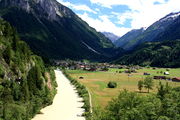Aar
| Aar | |
|---|---|
 The Aar at Bern |
|
| Origin | Canton of Bern, Switzerland |
| Mouth | Rhine |
| Basin countries | Switzerland |
| Length | 295 kilometres (183 mi) |
| Basin area | 17,779 km2 (6,865 sq mi) |
The Aar (German Aare), a tributary of the Rhine, is the longest river that both rises and ends entirely within Switzerland.[1]
Its total length from its source to its junction with the Rhine comprises about 295[2] km (183 miles),[1] during which distance it descends 1,565 m (5,135 ft), draining an area of 17,779 km2 (6,865 sq mi).[2]
Contents |
Course

The Aar rises in the great Aar Glaciers of the Bernese Alps, in the canton of Bern and west of the Grimsel Pass.[1] It runs east to the Grimsel Hospice, below the Finsteraarhorn, and then northwest through the Haslital, forming on the way the magnificent Handegg Waterfall, 46 m (151 ft), past Guttannen, and piercing the limestone barrier of the Kirchet by a major canyon, before reaching Meiringen, situated on a plain. A little past Meiringen, near Brienz, the river expands into Lake Brienz where it becomes navigable. Near the west end of the lake it receives its first important tributary, the Lütschine. It then runs across the swampy plain of the Bödeli between Interlaken and Unterseen before flowing into Lake Thun.[1]

Near the west end of Lake Thun, the river receives the waters of the Kander, which has just been joined by the Simme. On flowing out of the lake it passes through Thun, and then flows through the city of Bern, passing beneath eighteen bridges and around the steeply-flanked peninsula on which the Old City is located. The river soon changes its northwesterly flow for a due westerly direction, but after receiving the Saane or Sarine it turns north until it nears Aarberg. There, in one of the major Swiss engineering feats of the 19th century, the Jura water correction, the river, which had previously rendered the countryside north of Bern a swampland through frequent flooding, was diverted by the Hagneck Canal into Lake of Bienne. From the upper end of the lake the river issues through the Nidau-Büren channel and then runs east to Büren. The lake absorbs huge amounts of eroded gravel and snowmelt that the river brings from the Alps, and the former swamps have become fruitful plains: they are known as the "vegetable garden of Switzerland".
From here the Aar flows northeast for a long distance, past the ambassador town Solothurn[1] (below which the Grosse Emme flows in on the right), Aarburg (where it is joined by the Wigger), Olten, Aarau,[1] near which is the junction with the Suhre, and Wildegg, where the Hallwiler Aa falls in on the right. A short distance further, below Brugg it receives first the Reuss, and shortly afterwards the Limmat. It now turns due north, and soon becomes itself an tributary of the Rhine, which it surpasses in volume when the two rivers unite at Koblenz (Switzerland), opposite Waldshut, Germany.
Aar Gorge

The Aar Gorge (Aareschlucht) is a section of the river that carves through a limestone ridge near the town of Meiringen. The gorge is an indirect product of glaciation; 10,000 years ago, just as the Ice Age was coming to an end, torrential runoff water from melting glaciers eroded a deep, narrow chasm through the limestone barrier. Although barely one mile long, this passage is bordered by sheer cliffs up to 165 feet (50 m) high on either side. At the bottom of this steep drop the river is scarcely three feet (one meter) wide.
The gorge has been opened to the public since 1889, by building walking paths along the Gorge. Before then, the only way was to go through the dangerous river torrent, which provided fables by travellers, who claimed to see large snakes and monsters. Since then, the gorge is a popular tourist attraction for many visitors who like natural beauty and are attracted by the Reichenbach Falls, which Sir Arthur Conan Doyle selected as the proper set for Sherlock Holmes' murder by Professor Moriarty.
Tributaries
_IMG_6765.jpg)

- Limmat
- Sihl
- Linth (main tributary of Lake Zürich)
- Reuss River (see also: Reuss River#Tributaries)
- Kleine Emme
- Sarner Aa
- Engelberger Aa
- Schächen
- Furkareuss
- Suhre
- Wigger
- Emme
- Zihlkanal
- Suze
- Broye
- Orbe
- Saane (Sarine)
- Sense
- Kander
- Simme
- Allenbach
- Lütschine
Reservoirs
- Lake Wohlen, 481 m
- Niederriedsee, 461 m
- Klingnauer Stausee, 318 m
History
The river's name may be attested to in the Gaulish (Helvetic) Berne zinc tablet which dates back to Roman Gaul. Its Roman name was Obringa.
References
- ↑ 1.0 1.1 1.2 1.3 1.4 1.5 Bridgwater, W. & Beatrice Aldrich. (1966) The Columbia-Viking Desk Encyclopedia. Columbia University. p. 11.
- ↑ 2.0 2.1 "Aare River." Encyclopædia Britannica. 9 January 2007
External links
|
||||||||||
